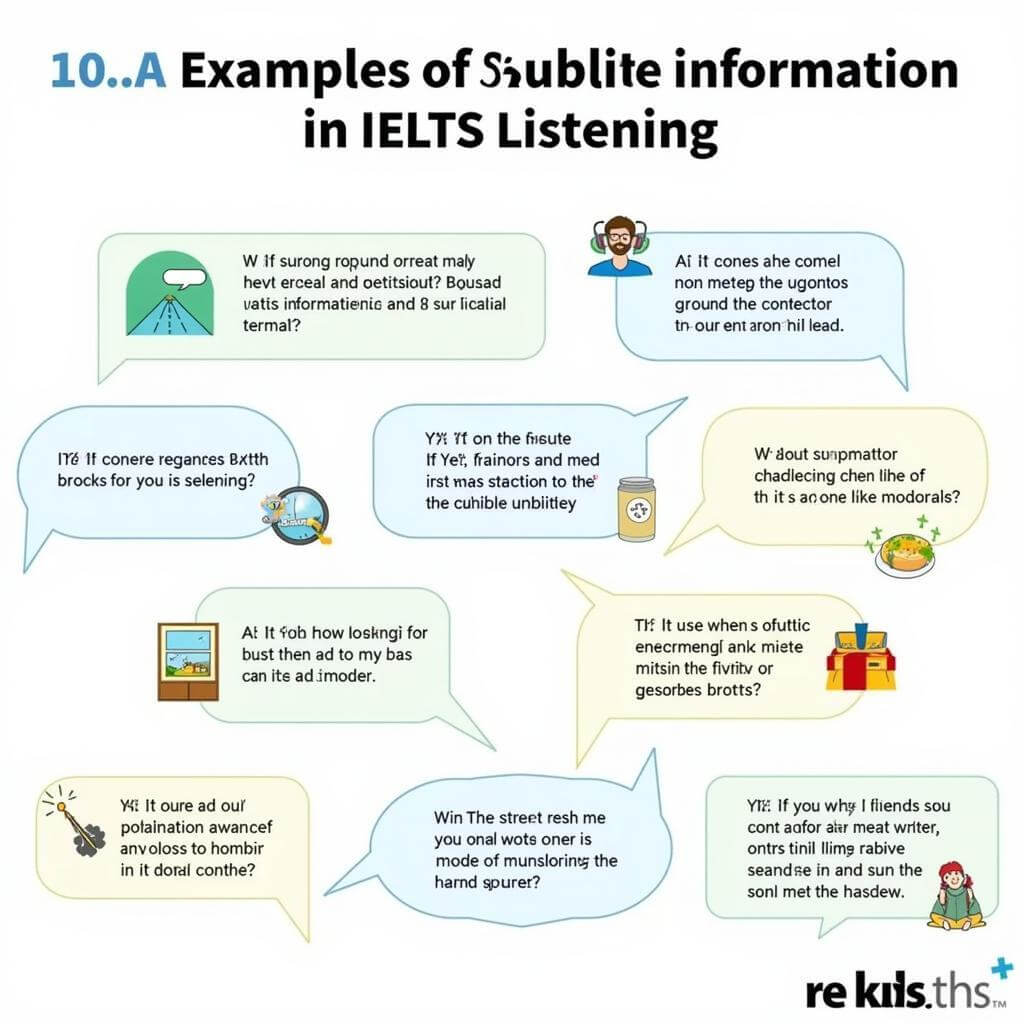Listening for subtle information is a critical skill in the IELTS listening test. It requires keen attention to detail and the ability to pick up on nuanced cues within spoken English. As an IELTS instructor with over two decades of experience, I can attest to the importance of this skill in achieving a high band score. Let’s explore how you can enhance your ability to detect and understand subtle information in IELTS listening.
Nội dung bài viết
- Understanding Subtle Information in IELTS Listening
- Types of Subtle Information
- Examples of Subtle Information in IELTS Listening
- Applying Subtle Information Skills to IELTS Listening Tasks
- Strategies for Detecting Subtle Information
- Common Mistakes When Listening for Subtle Information
- Practice Techniques for Improving Subtle Information Detection
- Targeted Listening Exercises
- Conclusion
Understanding Subtle Information in IELTS Listening
Subtle information refers to details that are not explicitly stated but are implied or presented in a less obvious manner. These details can be crucial for answering questions accurately in the IELTS listening test. Focusing on speaker emphasis is one way to detect such information, as speakers often use tone and stress to highlight important points.
Types of Subtle Information
- Implied meanings
- Tone and attitude
- Contextual clues
- Indirect statements
- Idiomatic expressions
- Changes in speaker’s voice
- Paraphrasing of key ideas
- Background information
- Hesitations or pauses
- Non-verbal cues (in video-based listening tasks)
Understanding these various forms of subtle information will help you navigate the complexities of the IELTS listening test more effectively.
Examples of Subtle Information in IELTS Listening
Let’s examine some examples to illustrate how subtle information can appear in IELTS listening tasks:
- Implied agreement: “Well, I suppose that could work.” (The speaker reluctantly agrees)
- Tone indicating sarcasm: “Oh, great. Another meeting.” (The speaker is not actually pleased)
- Contextual time reference: “Back when phones had cords…” (Implying it was a long time ago)
- Indirect refusal: “I’m quite busy this weekend.” (Politely declining an invitation)
- Idiomatic uncertainty: “It’s up in the air at the moment.” (The situation is uncertain)
- Voice change indicating importance: “This part is crucial…” (Said with emphasis)
- Paraphrased conclusion: “So, what you’re saying is…” (Restating the main idea)
- Subtle background detail: “As a lifelong vegetarian…” (Providing context for the speaker’s perspective)
- Hesitation showing doubt: “I’m… not sure that’s correct.” (The speaker disagrees politely)
- Non-verbal cue: Sound of papers shuffling (Indicating a change of topic or searching for information)

Applying Subtle Information Skills to IELTS Listening Tasks
To effectively apply your skills in detecting subtle information, you need to be familiar with the various question types in the IELTS listening test. How to answer sentence completion questions in IELTS listening is particularly relevant, as these often require you to pick up on nuanced details.
Strategies for Detecting Subtle Information
- Listen for changes in tone and emphasis
- Pay attention to context and background information
- Look for paraphrasing of key ideas
- Be aware of idiomatic expressions and their meanings
- Notice hesitations or pauses that might indicate uncertainty or importance
- Focus on transitional phrases that might signal a change in topic or perspective
Focusing on transitions in group listening can be particularly helpful when dealing with dialogues or discussions in the IELTS listening test.
Common Mistakes When Listening for Subtle Information
Awareness of potential pitfalls can help you avoid common errors:
- Misinterpreting tone or sarcasm
- Overlooking implied meanings
- Focusing too much on explicit statements and missing subtle cues
- Failing to consider the context of the conversation
- Ignoring non-verbal cues in video-based listening tasks
- Misunderstanding idiomatic expressions
- Not recognizing paraphrased information
Practice Techniques for Improving Subtle Information Detection
Enhancing your ability to pick up on subtle information requires dedicated practice. Here are some effective techniques:
- Listen to a wide variety of English accents and dialects
- Practice with authentic IELTS listening materials
- Watch English-language movies and TV shows without subtitles
- Engage in conversations with native English speakers
- Analyze tone and attitude in different contexts
- Practice paraphrasing exercises to improve your ability to recognize reworded information
- Work on expanding your idiomatic and colloquial English vocabulary
Tackling fast-paced conversations is another crucial skill that complements your ability to detect subtle information, especially in the later sections of the IELTS listening test.
Targeted Listening Exercises
- Tone Analysis: Listen to short audio clips and identify the speaker’s attitude or emotion.
- Implication Spotting: Practice identifying what is implied but not directly stated in conversations.
- Context Clues: Listen to longer passages and answer questions about background information that wasn’t explicitly mentioned.
- Idiom Recognition: Create a list of common idioms and practice identifying them in natural speech.
- Paraphrase Matching: Listen to a statement and match it with its paraphrased version from a list of options.
Conclusion
Mastering the art of listening for subtle information is a game-changer in the IELTS listening test. It requires practice, patience, and a keen ear for nuance. By understanding the types of subtle information, practicing with targeted exercises, and avoiding common pitfalls, you can significantly improve your performance in this critical aspect of the test.
Remember, the key to success lies in consistent practice and exposure to a wide range of English language content. Focusing on key speaker phrases will further enhance your ability to catch important details, both subtle and explicit.
As you continue your IELTS preparation journey, keep refining your skills in detecting subtle information. It’s not just about hearing the words; it’s about understanding the layers of meaning behind them. With dedication and the right approach, you’ll be well-equipped to tackle even the most challenging listening tasks in your IELTS exam.